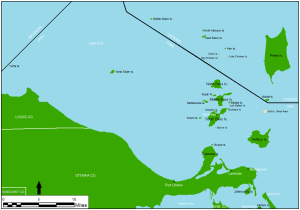I am baffled by the title of this piece, but, according to Civil War Home, the activities described were part of the Confederate government’s 1864 attempt to foment a Northwest Conspiracy, a “secret operation to create hostile activities in the Northwest, specifically another secession movement against the Union government–thereby, hopefully, the Union would sue for peace to prevent a further breakup”
From the Richmond Daily Dispatch September 24, 1864:
Another Chesapeake affair.
Under this caption, the Gazette has the following dispatch:
New York,September 20.–Buffalo dispatches state that a number of Confederates from Canada captured two small steamers — the Parsons and Island Queen — near Bass island, on Lake Erie, yesterday afternoon, and have gone up or down the lake, probably for reinforcements, guns and ammunition.
The capturing party numbered about thirty men, armed with revolvers and bowie-knives. No other arms were noticed. The capture took place at Middle Bass island. Wood enough was taken to last two days.
The CIA sheds some light on the details of this operation, which was part of an attempt to free Confederate prisoners at Johnson’s Islandby first taking over the U.S.S. Michigan, which guarded Lake Erie:
On September 19, 1864, John Yates Beall, a veteran blockade runner, and about 20 men boarded the Philo Parsons, a small Detroit-Sandusky steamer, in Detroit as ordinary passengers. At Beall’s request, the captain made an unscheduled stop at Amherstburg on the Canadian side of the Detroit River, and several more of Beall’s men boarded, toting a large trunk filled with grappling hooks for seizing the Michigan.
As the Philo Parsons neared Johnson’s Island, Beall put a pistol to the helmsman’s head and took over the ship. The Confederate flag was hoisted, and the real passengers and most of the crew were put ashore on another island. Then Beall sailed the steamer to a point off Johnson’s Island and awaited a signal from the Michigan.
A genial Philadelphia banker–and a new friend of the captain of the Michigan–was supposed to signal Beall that all was clear for the attack. However, the supposed banker, who was really Captain Charles H. Cole of the Confederate Army, had been arrested by Union soldiers. Cole, Confederates later said, had been betrayed. Union records show that Cole, captured on a tip from a Confederate captive and held aboard the Michigan, “disclosed the whole plot” in time for the Union warship to prepare for battle. Seeing no signal and fearing that the Michigan had been alerted, Beall’s crew, murmuring mutiny, demanded that he abort the attack. He set course for Canada, landed everyone ashore, and then burned the Philo Parsons.
The Johnson’s Island link above provided some insight about the baffling Chesapeake title of the Dispatch piece. John Yates Beall “was qualified for the raid by his success in Chesapeake Bay as a Privateer.”

